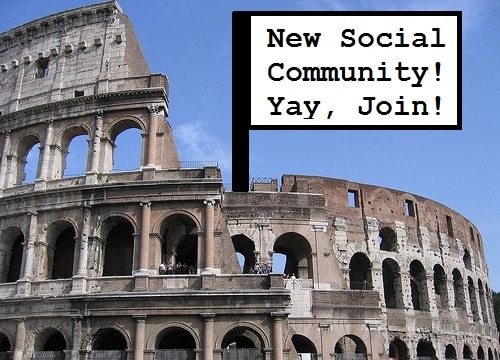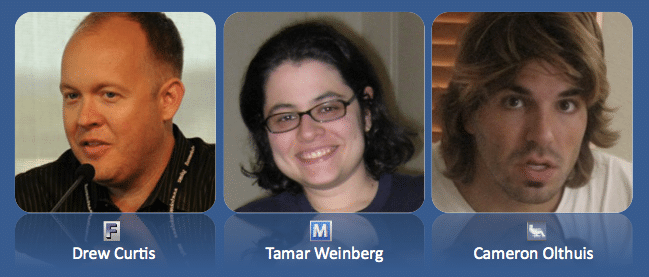If You Build It, Will They Come?... that’s the question on the minds of many community managers. It was also the first of many topics discussed during the #BlueGlassFL Day 2 late morning session, The Power of the Community – Leveraging and Mobilizing Organic Online Communities. Say it’s built, and “they” come… once those community users are present, the question takes on a new focus: how should you interact with, engage and nurture that community to keep them coming back and telling their friends?
Chris Winfield moderated the discussion between CEO of Fark.com, Drew Curtis, Community Manager at Mashable and Author of The New Community Rules, Tamar Weinberg, and the Director of Audience Development at Clicker, Cameron Olthuis. The session adopted a candid Q&A format, with Chris posing questions to the panelists who then shared their  rather diverse (and as such, much-appreciated) responses. AIMCLEAR live-tweeted this dynamic session— a recap of the tactics & takeaways resides below the fold.
Chris kicked things off by asking the panelists to introduce themselves and share a bit of their background.
Drew’s company, Fark, is 12 years old. In Internet years, that’s, like, 1 billion years old. If you haven’t heard of Fark, congratulations!– that means you must work really hard (the site, self-described as brimming with “satirical views on interesting, bizarre and amusing stories, submitted by a community of millions of news junkies” can make for a helluvan entertaining time-suck). Drew runs his business out of his home in Kentucky, not feeling the need for an office (he affirms he’d much rather spend the money on beer). All but one Fark employee, aside from Drew, actually lives in Kentucky. The rest work remote.
According to Drew’s human-to-Internet-age logic, Tamar’s been at Mashable for roughly 400 million years. It’s at Mashable that she facilitates the role of Community Support Advertising Manager. Tamar’s also the author of The New Community Rules, a book SmallBizTrends considers totally worthy of room on your marketing resource bookshelf.
Cameron’s been at Clicker.com since June, so figure that puts him around his 100,000th Internet birthday. As Director of Audience Development, he oversees strategy for SEO, social media and community management. Cameron got his start when he created a BMW enthusiast site, which grew to over 100k users and 1 million forum posts.
After the friendly “get to know ya,” the questions rolled out.
Q: When you think about community how do you define community?
Drew warned those in charge of building community need to be careful they don’t accidentally kill it off. He’s seen instances of community managers seeding controversy to the point that it drove others to abandon (member)ship. For Drew, it was cool to see his community take off by itself. He enjoyed watching relationships build on their own.
Tamar noted that people generally join communities because they want to be a part of something. They want to be affiliated with like-minded individuals. Online communities cut across geographic borders and provide a venue for interest-based relationships to flourish.
For Clicker.com, Cameron said, it is more about building a social layer that surrounds the core of their product.
Q: A lot of people wonder, “I have a community, how do I make my people passionate about my business?”
Cameron asserted that for his company, it’s not about being passionate about our brand. Because our product is built around TV, people already tend to be passionate about being here. The social aspect is built around empowering those people, listening to them, being active, watching what features they’re using (and which ones they’re not) and trimming the fat.
Tamar’s advice: when you focus on a community, remember that it’s not about you; it’s about them. Give them what they want– empower them and be receptive by showing them that you care. They’re not just participants, they’re participants with meaning.
Drew maintains that you can’t make people passionate about something– they either are or they aren’t. Community members can be a lot like a 5 year old– they like to step over the line and say, “What are you going to do about it?” Rules must be in place that essentially say, “If you’re going to be an enormous a-hole, then get out of here.” Drew would rather have a smaller community with people he wants to hang out with than a large community of ingrates and @$$holes. You need to set the bar somewhere, otherwise it all will blow up.
Q: How do you identify brand evangelists and how do you make it easier for them to spread the word about you?
For Cameron, it means mining through lots of data. Dig deep and see how people are using the site… how are they using the content outside of the site. Over at Fark, his team uses a few tools including Crazy egg & Google Analytics, and always running after invaluable feedback from power users. It’s a key combination of using the right tools and looking in the right places.
For Tamar, it’s also a matter of data mining. She leverages Backtype, a service that strictly monitors comments. Also in her toolbox is Mint, which aggregates & displays referrals real-time. At the end of the day you need to show brand evangelists love. Maybe that love is in the form of monetary compensation (discounts, swag)… maybe it’s exclusive access to a product in beta. Whatever it is, show them they’re valued beyond regular conversation.
Drew recommends asking the simple but powerful question, “What can I do to help?” If evangelists give you an answer you didn’t expect, act on it. If you run an online fishing community and you notice users are discussing NASCAR with increasing frequency, make a section dedicated to car chatter. Fark has a category strictly for funny cat photos (Caturday) that’s updated on a weekly basis. Lots of users traffic the site on Caturday & Caturday alone, to post their funny cat pictures. Yeah…
Drew has also noticed users driving conversation around specific events. Around the time of the Iranian election of 2009, a Fark community member from Israel, with heavy interest in Middle Eastern politics, began collating editorial and news media reports into condensed summaries on a day-to-day basis. His coverage of the events on Fark took off and evolved into a resource for professional journalists, and Fark offered the member a thread on the home page for a month.
Q: When do you know when to change things in your site based on that and what your original vision was?
“Basically, people hate change,” Drew smartly pointed out. His two rules of thumb regarding site change include: 1) If you make a change to the community and people are still mad after a few days, maybe there is actually a problem and 2) Do NOT change core functionality. Interestingly, this is just what Digg did. The social bookmarking site claimed they were making a revision but when everything was said & done, they’d scrapped the entire site for a new one (remarkably similar to Twitter’s interface). According to Drew, if you make a change–as long as you believe it is the right move (and you are in fact right), and you hold out long enough– you will eventually win.
Cameron considered Facebook as an example: When they rolled out the News Feed a few years back, despite many user complaints, they stuck with the vision they had for the product. Eventually, people got used to it. (And now, many can’t remember what the homepage looked like before it.)
Tamar pointed out that the News Feed was a product Facebook had been working on for several months prior to the roll out. Once it was released, the FB team received tons of back-lash, mainly because privacy issues weren’t set in place. Instead of pulling the change, they apologized and synergistically worked through user feedback to get it right.
Q: How much effort do you feel is appropriate to put into other social communities?
From a business perspective, Tamar recommended brands have some sort of business presence on their site that stands as a blog (feed). Heaven forbid one day your favorite social community goes down the tubes, you need some sort of community base that people can come back to.
Cameron’s tip was to test everything on a small scale… then to scale the hell out of what works.
Drew warned not getting too involved in one social network. Similar to Tamar’s point– yes, social networks will be with us for a long time, but they won’t be the same platforms. Whatever is going to be the next big thing probably already exists out there.
Q: If you have $10k to spend on boosting visibility and getting people involved, where would you spend it?
Cameron would put it into building a kick ass product. Without a good product, you’re kind of left in the same place, spinning your wheels. If you have a good product, it has potential to take off, to take on a life of its own.
In the midst of building a social network herself, Tamar recommends putting effort into identifying and reaching out to those in search of a product that will satisfy a particular need. Step two is bringing them in close.
Drew would throw a giant party with a little bit of a barrier to entry, so that only those that truly want to be there are there. Meeting people grows a bond and it has a direct impact on community.
—
Thank you to each of the panelists for their unique insight. Stay tuned tomorrow for AIMCLEAR‘s wrap-up of #BlueGlassFL!










